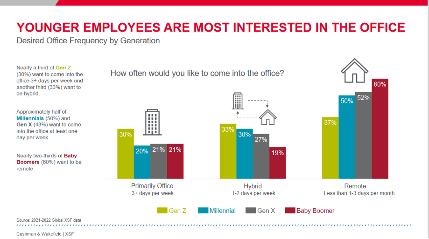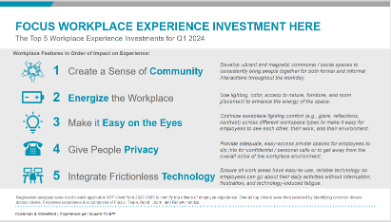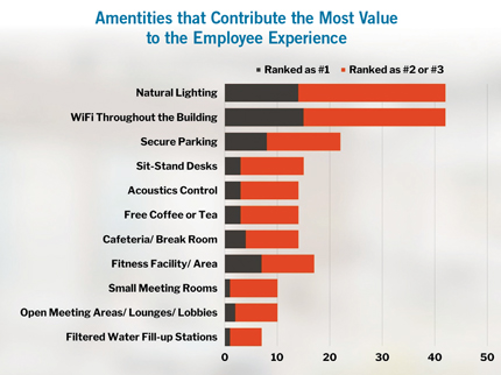With apology to Mark Twain, have the reports of the death of post-pandemic commercial office space been greatly exaggerated? We say yes! At the same time, we also acknowledge the profound changes the traditional office model has undergone over the last four years. As we explored in our Future of Work: Part 2, hybrid work environments can most certainly thrive – and, we believe, are here to stay, regardless of current ‘return to office’ mandates.
This resonates with Mark Rauch, Principal at commercial real-estate firm Cresa. He sees the continuation of the three main models coming out of the pandemic – centralized workplaces, decentralized remote organizations, and hybrid work arrangements. Most workers, he notes, prefer the hybrid model.
 Office space square footage may be declining, but hybrid work environments still require offices. For every Gen X worker celebrating saved commutes, younger employees crave in-person interaction. In this blog, we look at what we see as the most important trends in design that recalibrate how to best meet employees’ shifting office priorities. Read on for information and inspiration.
Office space square footage may be declining, but hybrid work environments still require offices. For every Gen X worker celebrating saved commutes, younger employees crave in-person interaction. In this blog, we look at what we see as the most important trends in design that recalibrate how to best meet employees’ shifting office priorities. Read on for information and inspiration.Cushman & Wakefield: Workplace Employee Experience Q1 2024. Person, Rick & Lindy. Jan 2024.
Shrinking Footprints
For small and mid-sized businesses, economic considerations are driving a trend of trimming leased square footage. In fact, recent reports suggest that a whopping 75% of companies polled plan to cut office space – even in the face of 88% of the companies surveyed mandating a certain number of days onsite. 1
Matthew Kelley is a partner in the New York office of Frederick Fisher and Partners, winner of the 2024 American Institute of Architects Firm Award. He and his firm have seen the trend of ‘right-sizing’ office spaces, sometimes by shrinking footprints through clever layouts.
“We saw the benefits of a denser desk layout since people are in the office less and desire more interaction and mentoring when they are in,” he shared. But Kelley cautions from his firm’s own experience that conflicting web meetings taken in tighter, open-space environments pose challenges. Private spaces are still needed – just in a different ratio than in the era of individual offices. “These trends also highlight the need for a higher percentage of conference rooms and phone rooms per employee for acoustic separation.”
Southern California is witnessing an interesting spin on this right-sizing trend, according to Lindy Pearson, Client Relations Specialist at Cushman & Wakefield. She observes that while larger companies are ‘right-sizing’, companies with fewer than 20 employees are shifting to co-working spaces given the region’s current commercial rents.
So, what constitutes right-sizing’?
Flexible and Adaptable
Say goodbye to purely open-space floorplans with assigned desks. Hoteling (designating an office or cube to a few employees with staggered in-office schedules) and hot desking (employees book an office or a desk for a set amount of time) are gaining prominence, Pearson says. The phone rooms that Kelley mentioned intentionally harken back to phonebooth days. These are small, preferably soundproofedspaces with enough room for one or two people to conduct a client call or hold a private conversation.
Outside of these conference and phone rooms, employees’ desire for larger shared collaboration environments is spiking.
 Community and Wellness
Community and WellnessPearson describes larger communal kitchens gaining popularity not for ‘water-cooler’ chats, but because employees deliver great results through constructive brainstorming sessions held over cups of coffee. (In other words, those kitchens need Smart Boards and WI–FI.) AtCushman & Wakefield, customers set aside quiet rooms that can be scheduled for yoga classes, decompression time, andwellness-building activities like sound baths.
“Huge kudos to business owners who are giving a lot of thought to their employees,” Pearson adds. “Those on this wellness bandwagon are reporting thriving cultures and high levels of productivity.”
According to the Commercial Real Estate Development Association NAIOP2 another big contributor to employee satisfaction is mother nature. Natural light is the number one most desired office feature, appreciated in in-person office experiences.
With employees increasingly demanding employers to care about and nurture their total wellness (see our Future of Work: Part 1), it’s no surprise that office space design increasingly reflects that need. Managers should feel good that these office features represent a win-win, since the emphasis is on spaces that provide collaboration and productivity.
 Smart and Seamless
Smart and Seamless
Pearson uses the great word ‘frictionless’ to describe the IT experience a company needs to deliver for successful hybrid environments. Every computer needs to be set up to work as easily via remote as in-office so that employees don’t lose productivity or gain resistance to coming in. If a small business doesn’t have an in-house IT team, consider finding an outsourced provider. (Feel free to ask us for our referrals!)
Evolution, Not Revolution
As you can see, the interplay of shifting economic considerations, employee preferences, and technologies shape 2024’s office space trends. Collaboration takes center stage, with a strong commitment to individual wellness and office culture wellness right beside it. We’re excited to see businesses embrace this more people-centric approach this year!
Footnotes:

